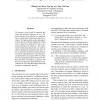Free Online Productivity Tools
i2Speak
i2Symbol
i2OCR
iTex2Img
iWeb2Print
iWeb2Shot
i2Type
iPdf2Split
iPdf2Merge
i2Bopomofo
i2Arabic
i2Style
i2Image
i2PDF
iLatex2Rtf
Sci2ools
ACL
2011
2011
Automatically Evaluating Text Coherence Using Discourse Relations
We present a novel model to represent and assess the discourse coherence of text. Our model assumes that coherent text implicitly favors certain types of discourse relation transitions. We implement this model and apply it towards the text ordering ranking task, which aims to discern an original text from a permuted ordering of its sentences. The experimental results demonstrate that our model is able to significantly outperform the state-ofthe-art coherence model by Barzilay and Lapata (2005), reducing the error rate of the previous approach by an average of 29% over three data sets against human upper bounds. We further show that our model is synergistic with the previous approach, demonstrating an error reduction of 73% when the features from both models are combined for the task.
| Added | 23 Aug 2011 |
| Updated | 23 Aug 2011 |
| Type | Journal |
| Year | 2011 |
| Where | ACL |
| Authors | Ziheng Lin, Hwee Tou Ng, Min-Yen Kan |
Comments (0)

